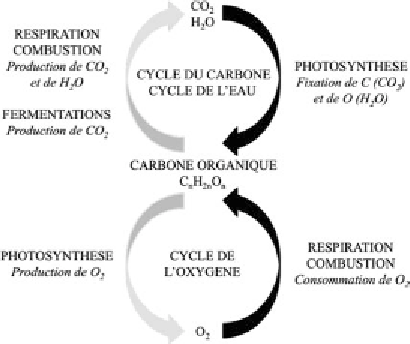Geoscience Reference
In-Depth Information
user, for respiration (all aerobic organisms) [
3
] and the decomposition
of organic matter (heterotrophic bacteria) in the water column [
4
] as
well as in the sediments and soil [
5
]. The oxygen cycle is coupled with
both the carbon and water cycles (Figure 4.5).
PHOTOSYNTHESIS
Production of CO
2
and H
2
O
CARBON CYCLE
WATER CYCLE
Fixation of C (CO
2
)
and O (H
2
O)
FERMENTATION
Production of CO
2
ORGANIC CARBON
PHOTOSYNTHESIS
OXYGEN
CYCLE
Production of CO
2
Consumption of O
2
Figure 4.5.
The biological processes of photosynthesis (oxygenic) and respiration
(aerobic) and the physico-chemical process of combustion couple the carbon cycle
with the water and oxygen cycles. Fermentation also couples the carbon cycle with
these other two cycles (adapted from a figure published on the site “Biologie et
Multimédia” of University Pierre and Marie Curie (www.snv.jussieu.fr/bmedia/
Photosynthese-cours/01-organisms.htm) with permission from UFR 927 “Sciences de
la Vie”)
The burial of organic material in the lithosphere [
6
] may prevent it
from being combusted, respired or decomposed for very long periods
of time. For example, peat (formed in the soil) may exist for thousands
of years and its products of transformation (including lignite, coal,
bituminous coal and anthracite) for millions of years to hundreds of
millions of years. Part of the fossil organic matter that accumulates in
the marine sediments [
7
] is transported toward continents by tectonic
plate movements (orogensis) [
8
]. Magmatic rocks (basalt) form the
substrate on which marine sediments deposit (oceanic plates) [
8
]. On
land, different processes consume O
2
, including the natural weathering
(oxidation) of rocks [
9
] as well as the combustion of peat and [
10
]
fossil organic matter [
11
] by human societies









